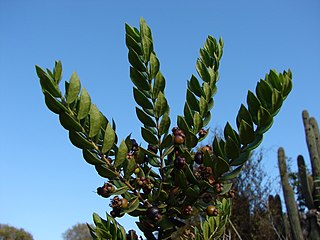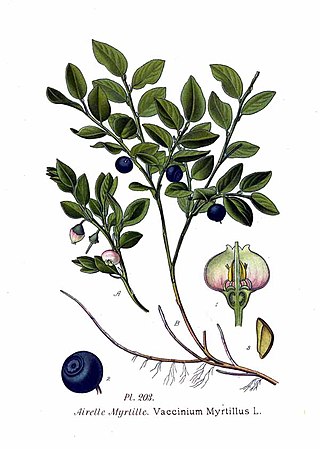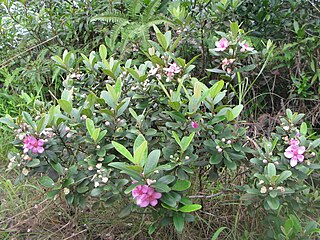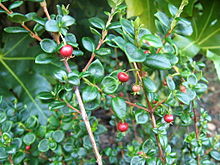
Myrtus is a genus of flowering plants in the family Myrtaceae. It was first described by Swedish botanist Linnaeus in 1753.

Aristotelia serrata, commonly known as wineberry or in the Māori language makomako or just mako, is a small tree in the family Elaeocarpaceae, in the genus Aristotelia, found in the North Island, South Island and Stewart Island of New Zealand. It is a small deciduous fast-growing tree or shrub. The tree can reach up to 10m tall, with a trunk diameter up to 30 cm. The bark is pale brown, smooth and patterned with flat lenticels. Branches are long, slender and spreading, branchlets have a reddish-brown colour when pubescent.

Santa Clara Island is a tiny, uninhabited island in the Pacific Ocean, off the coast of Robinson Crusoe Island in a group of islands known as the Juan Fernández Islands. The island is of volcanic origin and is approximately 1 km (0.6 mi) long and 0.6 km (0.4 mi) wide. The island group is politically part of the South American country Chile, and is administratively assigned to the Region of Valparaíso.

Ugni is a genus of plants in the myrtle family Myrtaceae, described as a genus in 1848. It is native to western Latin America from the Valdivian temperate rain forests of southern Chile and adjacent regions of southern Argentina, north to southern Mexico.

Luma chequen, the white Chilean myrtle, is a species of flowering plant in the genus Luma in the family Myrtaceae, native to the central Andes mountains between Chile and Argentina, at latitudes located 30 to 41° South. Synonyms include Eugenia chequen Molina, Myrtus chequen (Molina) Spreng., and Luma gayana (Barn.) Burret. Common names in Spanish include chequén, huillipeta, and arrayán blanco.

Vaccinium myrtillus or European blueberry is a holarctic species of shrub with edible fruit of blue color, known by the common names bilberry, blaeberry, wimberry, and whortleberry. It is more precisely called common bilberry or blue whortleberry to distinguish it from other Vaccinium relatives.

Rhodomyrtus tomentosa also known as rose myrtle, is a flowering plant in the family Myrtaceae, native to southern and southeastern Asia, from India, east to southern China, Hong Kong, Taiwan and the Philippines, and south to Malaysia and Sulawesi. It grows in coasts, natural forest, riparian zones, wetlands, moist and wet forests, bog margins, from sea level up to 2400 m elevation.

Viburnum trilobum is a species of Viburnum native to northern North America, from Newfoundland west to British Columbia, south to Washington state and east to northern Virginia. It is very closely related to the European and Asian Viburnum opulus, and is often treated as a variety of it, as Viburnum opulus L. var. americanum Ait., or as a subspecies, Viburnum opulus subsp. trilobum (Marshall) Clausen.
Murta con membrillo is a typical dessert from southern Chile where the Chilean guava shrub is common. It is made by boiling the quince and Chilean guava berries together with sugar.
Murtado is a typical liqueur from southern Chile where the endemic Chilean guava grows. It is made by conserving fruit inside a bottle with aguardiente for some weeks and then mixing it with syrup.
The cranberry is a group of evergreen dwarf shrubs, bearing the fruit named after such.

Austromyrtus dulcis is a species of plant native to eastern Australia. It grows as a small spreading shrub and is easily recognised by its characteristic berries that usually ripen in summer and autumn. Common names include the midgen berry, midyim, and silky myrtle.

Myrtus communis, the common myrtle or true myrtle, is a species of flowering plant in the myrtle family Myrtaceae. It is an evergreen shrub native to southern Europe, North Africa, Western Asia, Macaronesia, and the Indian Subcontinent, and also cultivated.

Myrceugenia obtusa, also known as raran, is an evergreen tree endemic to Chile from Coquimbo to Cautin. It grows mainly in the coastal mountains on moist sites.

Styphelia humifusa, commonly known as native cranberry or cranberry heath, is a small prostrate shrub or groundcover in the heath family Ericaceae. The species is endemic to south-eastern Australia.

Las Vertientes Private Nature Reserve is a private Chilean nature reserve located in the Los Lagos Region, part of Chilean Patagonia. Created in 2009 as a nature reserve operated by the Corporación Nacional Forestal, its purpose is to protect the plants and animals of the Valdivian temperate rainforest. The 100 square kilometres (39 sq mi) reserve's work emphasizes restoration of the temperate rainforest ecosystem over being a public amenity. It is the only private protected area in Los Muermos.

Ugni candollei is a species of shrub, 80 cm in height, with white, 5-petal flowers, endemic to Chile. Its fruit is edible, and is used by natives to make a chicha. It is reported to be an oneirogen.

Myrteae is the largest tribe in the plant family Myrtaceae. It includes most of the species of the family that have fleshy fruits.
Myrteola nummularia is a species of plant in the Myrteola genus, which is found in the Falkland islands and southern parts of South America such as Patagonia. It is a small perennial shrub often wider than it is tall, which grows in marshy areas. It has edible berries which may be eaten fresh or used in the preparation of jams or liquors.
















